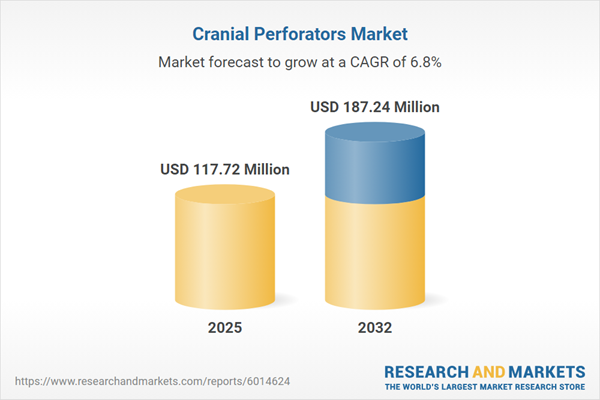Speak directly to the analyst to clarify any post sales queries you may have.
The cranial perforators market is undergoing significant transformation as senior leaders adapt procurement strategies to meet evolving regulatory and clinical requirements. Strategic insight is vital as organizations align neurosurgical device selection with operational goals while ensuring value-based care practices are met.
Market Snapshot: Growth Path and Competitive Positioning in the Cranial Perforators Market
Currently, the cranial perforators market is valued at USD 110.23 million. It is expected to reach USD 117.72 million by 2025 and USD 187.24 million by 2032, supported by a 6.84% compound annual growth rate due to higher procedure volumes and innovation in device development. Competitive positioning is shaped by advances in device features, adaptive reimbursement models, and the ability to respond to procurement trends and regulatory shifts across key regions such as the Americas, EMEA, and Asia-Pacific. Organizations must remain agile to adjust to supplier and pricing changes, which are increasingly influencing procurement and partnership decisions.
Cranial Perforators Market Scope & Segmentation
A comprehensive market scope enhances procurement precision by addressing device preferences, technology adoption, and regional considerations:
- Device Types: Battery powered, corded electric, and pneumatic options allow for versatile deployment in both acute and outpatient clinical settings, supporting a range of neurosurgical interventions and care models.
- End Users: Hospitals, ambulatory surgical centers, and specialty clinics prioritize devices that fit specific workflow requirements and can be seamlessly integrated into varied infrastructure.
- Distribution Channels: Direct sales, distribution agreements, and e-commerce are established to provide flexible, responsive procurement tailored to local buying practices and supply chain needs.
- Clinical Applications: Utilization spans neurology, oral and maxillofacial surgery, and orthopedics, enabling broad procedural support and adaptation across specialties.
- Sterilization Methods: Low temperature, radiation, and steam approaches are implemented to meet infection control mandates, enhance compliance, and ensure device safety.
- Geographies Covered: The report details activity across the Americas, EMEA, and Asia-Pacific, including in-depth regional profiles for the United States, Germany, China, Brazil, and Singapore, highlighting distinct adoption and regulatory patterns.
- Leading Companies: Competitive analysis includes Medtronic plc, Stryker Corporation, Zimmer Biomet Holdings, B. Braun Melsungen, Johnson & Johnson, Integra LifeSciences Holdings, KLS Martin Group, Medartis AG, De Soutter Medical, and Sklar Instruments Inc., supporting informed benchmarking and supplier selection.
Key Takeaways for Senior Decision-Makers
- Emergence of compact and ergonomic cranial perforators is enabling streamlined surgical workflows and broadening deployment possibilities across care settings.
- Rising quality assurance requirements drive adoption of stringent sterilization and material safety protocols, necessitating robust compliance management for both providers and manufacturers.
- Increased demand for portable and user-centric systems is creating new care access points outside traditional hospitals, supporting the shift toward outpatient and specialty care environments.
- Collaborative efforts between OEMs, clinicians, and research entities are accelerating device validation and supporting tailored solutions for a wider array of specialist interventions.
- The growth of digital sourcing platforms and group purchasing agreements is modernizing procurement workflows, improving sourcing flexibility and operational resilience amid regional market volatility.
Tariff Impact and Supply Chain Resilience
Upcoming import tariffs in 2025 are compelling organizations to revisit procurement processes to better mitigate cost variability and operational disruptions. Firms are adopting strategies such as domestic assembly, closer supplier partnerships, and group purchasing to control prices and ensure steady device availability. Companies with local manufacturing capacity exhibit greater resistance to supply chain interruptions, while those with heavier import reliance are diversifying supplier networks to protect margins and maintain supply continuity.
Methodology & Data Sources
The findings are derived from structured input from neurosurgeons, device engineers, and procurement leaders. Data is validated against recent peer-reviewed literature, regulatory updates, and analysis of public corporate filings to ensure relevant, accurate, and decision-oriented market perspectives.
Why This Report Matters
- Enables executives to synchronize procurement and technology adoption with ongoing compliance mandates in the cranial perforators sector.
- Delivers actionable global and regional insights on supplier dynamics, enhancing operational agility and market adaptation.
- Equips decision-makers with guidance to swiftly respond to shifts in market, regulatory, and technology landscapes, building stronger risk management frameworks and long-term growth potential.
Conclusion
This report provides targeted, evidence-based guidance to support senior leaders seeking to strengthen procurement efficiency, operational reliability, and future readiness in neurosurgical device strategies.
Additional Product Information:
- Purchase of this report includes 1 year online access with quarterly updates.
- This report can be updated on request. Please contact our Customer Experience team using the Ask a Question widget on our website.
Table of Contents
3. Executive Summary
4. Market Overview
7. Cumulative Impact of Artificial Intelligence 2025
Companies Mentioned
The companies profiled in this Cranial Perforators market report include:- Medtronic plc
- Stryker Corporation
- Zimmer Biomet Holdings, Inc.
- B. Braun Melsungen AG
- Johnson & Johnson
- Integra LifeSciences Holdings Corporation
- KLS Martin Group
- Medartis AG
- De Soutter Medical Limited
- Sklar Instruments Inc.
Table Information
| Report Attribute | Details |
|---|---|
| No. of Pages | 181 |
| Published | October 2025 |
| Forecast Period | 2025 - 2032 |
| Estimated Market Value ( USD | $ 117.72 Million |
| Forecasted Market Value ( USD | $ 187.24 Million |
| Compound Annual Growth Rate | 6.8% |
| Regions Covered | Global |
| No. of Companies Mentioned | 11 |









